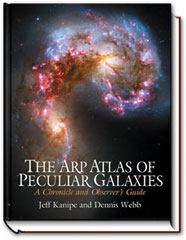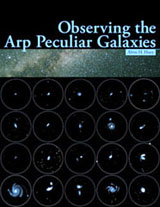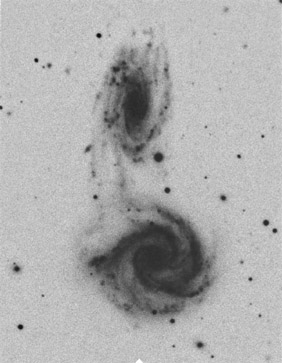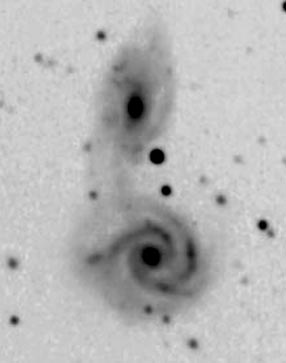|
[Observing the Arps]
[Summary Data]
Introduction
This page illuminates the catalog of 338
peculiar galaxy views gathered by Dr. Halton C. Arp in his Atlas of Peculiar
Galaxies. The Atlas is a selection of unusual or peculiar
galaxies, interacting pairs or larger groups.
As amateur telescopes grow
in capability and CCD cameras are becoming more
sensitive and affordable, amateur astronomers can grasp the faint peculiar
features of these remarkable views. This page provides data to support this
amateur pursuit, offering convenient information and contemporary galaxy
naming and characteristics.
Dr. Arp compiled the Atlas with photographs
he made mainly using the Palomar 200-inch telescope and the 48-inch Schmidt between 1961 and 1966.
The Atlas was published in the Astrophysical Journal Supplement
Number 123, Volume 14, November 1966, University of Chicago Press. A
small number of larger scale photographic prints of the Atlas were published
in 1966 and 1978. Caltech presents an
online
version of the Atlas, including Arp's original tabular data. Dr. Arp plays a unique role in
the debate on the nature of the universe in general and the galaxies in
particular, often standing alone in his assessments of observations on the
nature of observed redshifts and the cosmological implications. He
continues to research and publish, and is author or co-author of
many papers in the journals. For information about his current work,
visit his webpage at www.haltonarp.com.
Observing the Arp Peculiar Galaxies
The Astronomical League encourages observation of the Arps through
their
Arp Observer's Club,
recognizing those who have visually observed or imaged 100 of the peculiar
views,
70 individuals as of this writing.
The Atlas images were acquired with the Hale and Schmidt telescopes
of the Carnegie Observatories and
best photographic emulsions of the time, presenting very high resolution
of faint galactic details. Using varying
enlargements, Dr. Arp was able to uniformly present galaxies independent of
their angular size. He selected the fields to emphasize the features of
interest and, in the process, created some remarkable compositions.
These attributes represent three challenges to
the amateur observer:
- Wide range of field sizes - The Atlas offers 338
identically sized rectangular images, presenting field sizes
ranging from just over a degree (Arp 318) down to 2.2 arcminutes, with several size groupings in between.
Two thirds of the image fields are 3.6 arcminutes or smaller. (See
figure illustrating most field sizes).
This characteristic is particularly challenging to CCD imagers because of
the extreme range of focal lengths required.
- Faintness of the features of interest - While the 338 Arps
include many bright familiar galaxies, most of
the involved galaxies are magnitude 13 or fainter (see
figure). Further, the peculiar features
highlighted in the Atlas pictures are often very faint extensions
from the brighter usually observed parts of the galaxies. Most of
these features are accessible to CCD imaging, although many will be just
above the background noise. Skilled visual observers with large
aperture will find some peculiarity in most.
- Framing - While many of the Atlas images
are of one disturbed galaxy, most involve multiple galaxies. It is
not obvious from looking at a star chart, what objects and framing Dr. Arp
used. To
fully observe what attracted Dr. Arp, one should be familiar with the
original Atlas image.
Finding Arps to Observe
The 338 Arp fields range from familiar bright galaxies like M51 down
to faint 17th magnitude nearly-anonymous fleaspecks. Few starcharts or
observing guides reference the Arp number, so to find most Arps, the
observer must start with a reference that relates more commonly used galaxy
names to the Arp number. Some database programs and online sources
answer the question "what is Arp 32?" but observing planning benefits from
compact tables listing all of the Arps, their characteristics and
locations. As the galaxies become fainter, different sources will
disagree about what galaxy has what name, which causes some confusion.
Useful Summaries to Help Find Arps:
Arps in other catalogs: Messier, Herschel 400, and Hickson.
83 bright Arps (90 galaxies) in the Revised Shapley-Ames.
All 338 Arp
Fields in Arp sequence.
All Galaxies involved in the 338 Arps by Right
Ascension
Arps Sorted by Constellation.
Irregularities in identifying the galaxies involved in the Arps.
Where The Arps Are, a plot of locations in RA and Dec.
Magnitude Distribution of the brightest galaxies
in each Arp.
Note - these data are from the 1999 dataset published on this page.
These data will be revised to be consistent with the
Willmann-Bell Arp book,
which improves the uniformity of naming and characteristics.
On the subject of older datasets,
Nancy Roman
recruited the 1996 dataset as file Catalog 7192 in NASA's Astronomical Data
Center (ADC). The Centre de Donn astronomiques de Strasbourg
(CDS) now hosts these files as catalog
VII/192.
The CDS catalogs are mirrored in Japan, Russia, China, India, and the US.
Researchers interested in the Arps
John Hibbard at
NRAO studies interacting
galaxies:
Lots of pictures of
Arps
Colors of
Tidal Tails
HI Rogues
Bill Keel at the
University of Alabama studies galaxy
interaction.
Dr. Keel
is a contributor to the Hubble Heritage
collection.

About this page
This page is the result of a personal quest
by Dennis Webb to study and promote Halton Arp's list of peculiar galaxies. Members of the
Johnson Space Center Astronomical Society, the
Fort Bend Astronomical Club, and the
Houston Astronomical Society
supported the effort through analysis and data entry.
This page first developed in 1995, updated November 12, 2007.
Dennis Webb's Home Page
| Dennis Webb's Email
|
[Amateur
Observations] [References]
Books for Arp enthusiasts:
|
 Buy
| Samples |
Blog Buy
| Samples |
Blog |
Willmann-Bell's
Arp Atlas of
Peculiar Galaxies, A Chronicle and Observer's Guide by Dennis Webb
and Jeff Kanipe features 400 pages
of in-depth analysis of the 338 Arp fields, organized for the observer
with a reproduction of the original Atlas, monochrome amateur CCD
images of all, finder charts, interpretive diagrams, visual
observations, assessments of galaxy naming difficulties, and a
thoroughly researched chronicle of Arp and his Atlas. |

Buy |
Samples |
Alvin Huey's
Observing the Arp Peculiar
Galaxies features naked eye finder charts and a detailed page for
each of the 338 Arps with local finder chart, observing notes, labeled
DSS image and an eyepiece rendition. 456 pages, spiral bound. |

Selected Amateur Arp Observations
Arp observers share their Arp observations on their own webpages:
Visual observers' Arp narratives and sketches:
Ray Cashs Arp observations
Bob Hills Visual Arp Observations
Ron Muirs Flinthill Deep Sky Guide for the Arps:
Martin Schoenball 's www.arpgalaxies.com
Bruce Scodovas visual Arp observations
Jim Shields Arp Sampler (also Arp Galaxy Chains)
CCD Arp images:
Jim Burnell
Paul and Liz Downing
Ch. Dupriez (en Frans)
Ivar Hamberg
Tim Hunter and James McGaha (all 338 Arps)
Tracy Knauss and Mike Morton
Richard Miller (all 338 Arps)
Maynard Pittendreigh (his separate home page)
David Ratledge
Bob Ross
Dennis Webb
Spectacular amateur color CCD images of Arps
Selected images posted by hard-working astrophotographers:
Arps in your books and software:
Bright Star Atlas
locates 20 of the brighter Arps (6%).
Herald-Bobroff ASTROATLAS
locates about 210 Arps (63%).
Uranometria 2000.0 (1987) locates 202 Arps (60%).
Uranometria 2000.0
(2001) locates 303 Arps (90%).
Webb Society Deep Sky Observer's Handbook Vol 6, Galaxies
provides information for visually observing over 70 Arp views.
Out of print, it is dedicated to Dr. Arp who wrote the preface.
Burnham's
Celestial Handbook lists galaxies for 82 Arps (24%).
Night Sky Observer's
Guides describe galaxies for 106 Arps (30%).
The Arp Atlas of Peculiar
Galaxies, Chronicle and Observing Guide
offers detailed observational data for all 338 Arps
(100%).
Alvin Huey's Observing
the Arp Peculiar Galaxies
offers detailed observational data for all 338 Arps
(100%)
Carnegie Atlas of Galaxies
(not in print but online)
presents 77 Arps.
Vickers' Deep Space CCD Atlas: North (1994) shows 153 Arps.
Supplementary Arp Index available in
HTML or PDF.
Mr. Vickers offers a
later edition but this
table may still be usable.
Willmann-Bell's
MegaStar and HyperSky include Arp lists (Win).
Starry Night includes the Arp list (Win/Mac).
TheSky Professional edition
includes the Arps
(Win/Mac).
SkyMap offers an Arp
file (Win).
Bartels Scope-Drive offers an
Arp data file at
their Yahoo Group.
Argo-Navis offers an
Arp data file at
their Yahoo Group.
Hubble Space Telescope Images of Arps:
The
story of
Hubble Heritage's
image of Arp 87.
|




